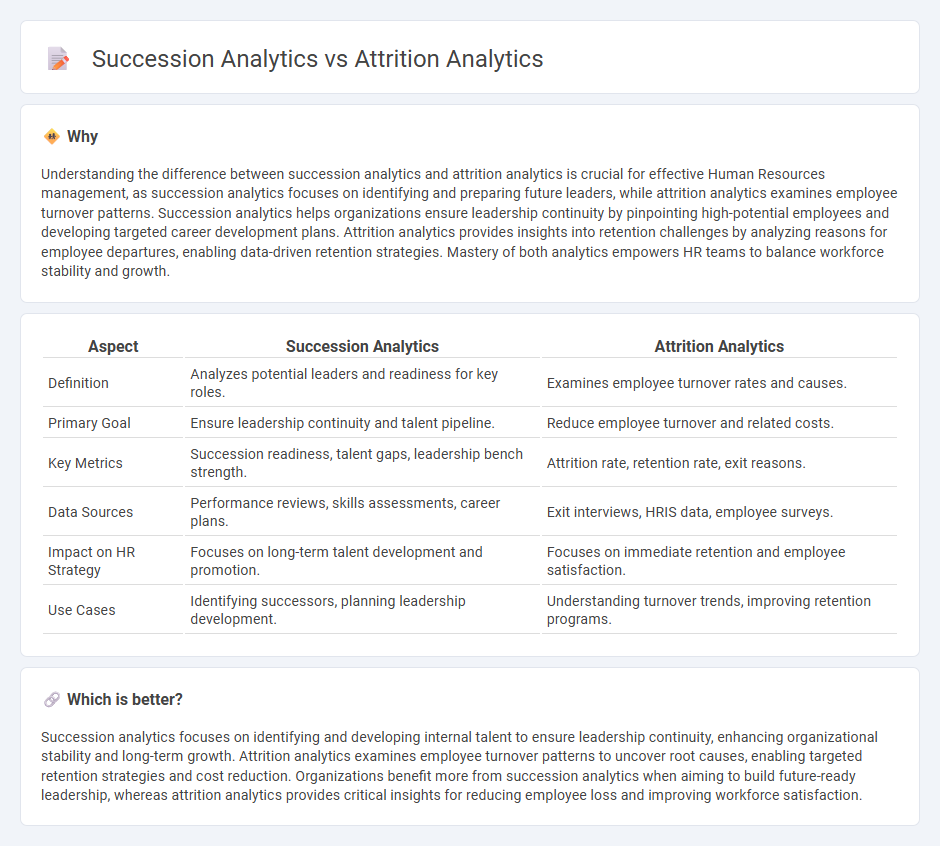
Succession analytics focuses on identifying and developing internal talent to fill key leadership roles, ensuring business continuity and strategic growth. Attrition analytics examines employee turnover patterns to minimize losses and improve retention strategies by understanding the root causes of employee departures. Explore how these analytics can transform workforce planning and enhance organizational resilience.
Why it is important
Understanding the difference between succession analytics and attrition analytics is crucial for effective Human Resources management, as succession analytics focuses on identifying and preparing future leaders, while attrition analytics examines employee turnover patterns. Succession analytics helps organizations ensure leadership continuity by pinpointing high-potential employees and developing targeted career development plans. Attrition analytics provides insights into retention challenges by analyzing reasons for employee departures, enabling data-driven retention strategies. Mastery of both analytics empowers HR teams to balance workforce stability and growth.
Comparison Table
| Aspect | Succession Analytics | Attrition Analytics |
|---|---|---|
| Definition | Analyzes potential leaders and readiness for key roles. | Examines employee turnover rates and causes. |
| Primary Goal | Ensure leadership continuity and talent pipeline. | Reduce employee turnover and related costs. |
| Key Metrics | Succession readiness, talent gaps, leadership bench strength. | Attrition rate, retention rate, exit reasons. |
| Data Sources | Performance reviews, skills assessments, career plans. | Exit interviews, HRIS data, employee surveys. |
| Impact on HR Strategy | Focuses on long-term talent development and promotion. | Focuses on immediate retention and employee satisfaction. |
| Use Cases | Identifying successors, planning leadership development. | Understanding turnover trends, improving retention programs. |
Which is better?
Succession analytics focuses on identifying and developing internal talent to ensure leadership continuity, enhancing organizational stability and long-term growth. Attrition analytics examines employee turnover patterns to uncover root causes, enabling targeted retention strategies and cost reduction. Organizations benefit more from succession analytics when aiming to build future-ready leadership, whereas attrition analytics provides critical insights for reducing employee loss and improving workforce satisfaction.
Connection
Succession analytics and attrition analytics are interconnected through their focus on workforce stability and talent management. Succession analytics identifies potential future leaders and critical roles at risk due to employee turnover, while attrition analytics examines patterns and causes of employee departures to reduce turnover rates. Integrating these analytics enables organizations to proactively address talent gaps by aligning retention strategies with leadership development plans.
Key Terms
**Attrition Analytics:**
Attrition analytics focuses on identifying patterns and causes of employee turnover by analyzing metrics such as exit interviews, tenure, job satisfaction, and performance data to predict and reduce future resignations. It leverages predictive modeling and sentiment analysis to uncover risk factors related to employee disengagement and retention challenges. Explore more about how attrition analytics drives strategic workforce planning and enhances employee retention.
Turnover Rate
Attrition analytics primarily examines turnover rate by analyzing employee exit patterns, reasons for departures, and the impact on organizational productivity, helping identify risk factors and trends. Succession analytics evaluates turnover rate in the context of leadership gaps, readiness of internal candidates, and the strategic planning needed to ensure smooth transitions in key roles. Explore how integrating attrition and succession analytics can optimize talent management and reduce costly turnover risks.
Exit Interviews
Attrition analytics focuses on understanding employee turnover by analyzing exit interviews to identify patterns such as reasons for leaving, dissatisfaction triggers, and organizational gaps. Succession analytics leverages exit interview data to assess leadership pipeline readiness and skill gaps, ensuring smooth transitions in key roles. Explore how integrating exit interview insights enhances both attrition mitigation and succession planning strategies.
Source and External Links
Employee Attrition Analytics: Understanding Employee Turnover - Employee attrition analytics identifies why employees leave and uses predictive data to design effective retention strategies by analyzing who leaves, when, and why to reduce unwanted attrition in evolving labor markets.
Attrition Analytics - Knoetic Knowledge Base - Attrition analytics tracks who leaves, when, and why, and includes predictive risk categories (low, medium, high) to inform strategies that reduce workforce churn by understanding termination patterns.
Employee Retention Software with Advanced Attrition Analytics - Qualtrics retention analytics connects attrition trends to employee experience, uncovering drivers of turnover and enabling proactive retention strategies to keep top talent and improve onboarding.
 dowidth.com
dowidth.com